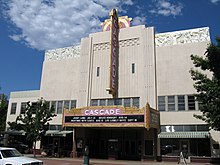Redding, California
In 1874, there was a dispute over the name by local legislators and it was changed for a time to Reading, in order to honor Pierson B.
Reading, who arrived in the area in 1843, owned the Buenaventura land grant on which Redding sits, and had died only a few years before, in 1868.
In the process of building the terminus, the railroad also built the town of Redding which was officially incorporated on October 4, 1887.
[8] In the early twentieth century the town's economic growth was spurred by the significant copper and iron mineral extraction industry nearby.
The building of the dam, which was completed in 1945, caused Redding's population to nearly double, also spurring the growth and development of other towns in the area.
The constructions of Whiskeytown and Keswick dams also helped boost the economy by bringing new workers to the area.
Growth in Redding during the 1960s and 1970s was further spurred by the annexation of an area east of the Sacramento River that included the unincorporated community of Enterprise; the residents voted to support the annexation primarily to acquire less expensive electricity via Redding's municipal utility, which receives power from the dam.
In the early 1990s Lumber mills in the area closed down due to the preservation of the living habitat of the Spotted Owl.
The mall was established to prevent further property deterioration and to restore and maintain the economic health of the downtown area's commercial and retail activity.
The passage of Proposition 13 in 1978 reduced the mall's property valuation and consequently, the city had to continuously loan money to keep the bonds for the mall's parking structure from going into default; the bonds completely repaid in 2003 and Midtown began to pay off its more than $1.5 million debt to the City of Redding.
By the 1980s, the properties around the mall and along the old State Highway 99/273 corridor continued to suffer urban blight, including deteriorating and dilapidated utilities and structures and inappropriate mixed land uses; this required further public intervention in the form of another Market Street Redevelopment Project with significant changes to Midtown in 1990 to include a mix of residential and commercial land around the original project.
A plan for the downtown area adopted in January 2001 led to the renovation of the historic Cascade Theatre, the removal of the Midtown Mall roof creating an open air pedestrian street, the installation of a visitor way-finding system, the completion of a Health Sciences and University Center with partnership with Shasta College, and the renovation of various buildings along California Street with the help of a private developer.
In late July 2018, the Carr Fire in Shasta County seriously impacted the Redding area with the destruction of at least 1,100[12] buildings, with several thousand more threatened, 38,000 people instructed to evacuate and 8 deaths.
The Shasta Dam on the Sacramento River provides a considerable level of flood protection for Redding.
[14] Soils in and around town are composed mostly of clay or gravelly loam texture, with red or brown mineral horizons.
This endemic grass is a Federal Candidate for listing and is endangered throughout its range, confined to several populations, and seriously threatened by agriculture, overgrazing, and residential development.
Redding has a hot-summer Mediterranean climate (Köppen: Csa), with very hot, dry summers and cool, wet winters.
The somewhat strange juxtaposition of its northern position within the United States and non-desert climate, with the extreme summer heat, has long been noted by visitors and residents.
[17][18][19] Winter (October–April) provides the most precipitation of any season in Redding—the weather tends to be either rainy or foggy and at times, snow occurs.
[21] Summer overnight lows are unusually warm by Sacramento Valley standards and average warmer than coastal towns' daytime highs.
[20] Redding's warm summer days and nights compared to areas further south are a result of a greater distance to maritime influences than the lower end of the valley.
The city is located near the foothills of the Cascade and Klamath mountain ranges and it therefore gets much more rain than most places in the Sacramento Valley.
The Northern parts of the city can get up to a few more inches of rain a year due to its closer location to the mountains; temperature differentials between land and sea cause moist air from the latter to flow over the southern Sacramento valley during the summer months, producing intense heat in Redding.
The direction of this winds switches from the north and east in the summer, as hot, high-pressure air flows from land to sea, making the area very dry.
According to the city's 2016 Comprehensive Annual Financial Report,[41] the top employers in Redding are: In the California State Legislature, Redding is in the 1st Senate District, represented by Republican Megan Dahle,[42] and the 1st Assembly District, represented by Republican Heather Hadwick.
[citation needed] Shasta Regional Transportation Agency has proposed a weekday commuter bus to/from Redding and the Sacramento Valley Station, following a route similar to the twice daily Amtrak Thruway 3.
There is also planned service by Core Airlines in late 2024 to other cities in Northern California, Southern Oregon, and Western Nevada.
This list includes notable persons who were born/raised/worked in, lived in, or whose identity was significantly influenced by Redding, as well as music groups that were founded in the area.













